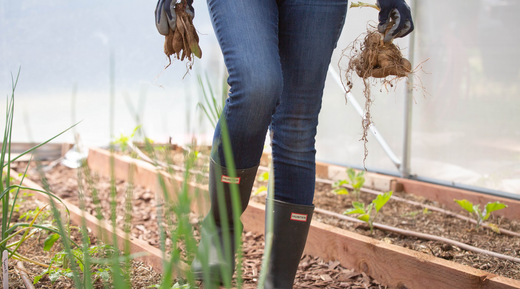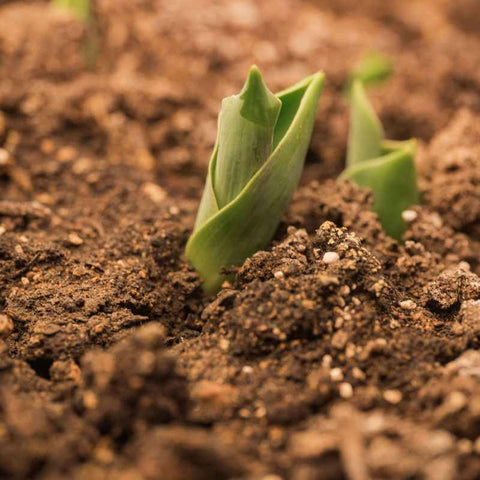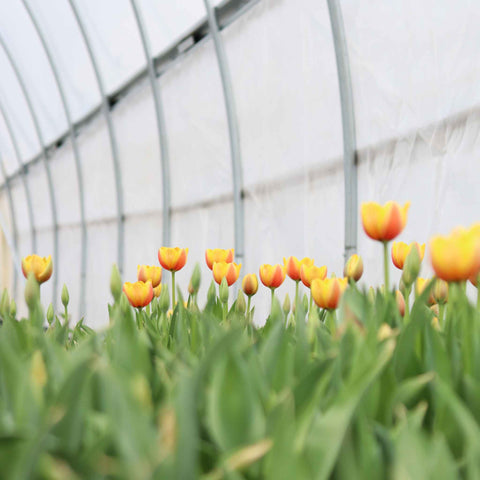20% Off USA-Made All-Metal Greenhouse Kits until May 31
20% Off USA-Made All-Metal Greenhouse Kits until May 31
Extending Spring Blooms
January 29, 2025 9 min read 0 Comments

Strategies for Choosing Spring Blooming Bulbs & Fall Planting
Flower farmers take pleasure in providing the earliest and brightest blooms to market. Spring blooming bulbs are some of the season's most beautiful and refreshing flowers. However, with air and ground temperatures fluctuating and parts of the season feeling uncertainly short, getting the most out of each growing season can be challenging.
Luckily, there are strategies you can use in the fall and into Spring to ensure that your flowers bloom as long as possible through springtime and beyond! Creating microclimates, pruning, early planting methods, fertilization techniques, and crop selection all have a place in extending beautiful blooms.
How do I extend the blooming season for spring bulbs?
As this is my second year of growing flowers for profit, finding ways to be first to market and have blooms early in the season is a huge focus. I am working to extend bloom times by influencing plants to progressively add blooms yearly through proper pruning and fertilization when I am keeping bulbs in the ground. For farmers pulling bulbs during harvest, strategically planting early, mid, and late-season spring-blooming bulbs that will bloom one after another gives you the greatest opportunity for profit.
Some climates may produce spring flowers easily, whereas others may require structures like hoop houses, caterpillar tunnels or low tunnels with frost blankets or shade cloth to create microclimates. These structures can get you to market with flowers weeks earlier in the spring, regardless of your growing zone.

Understanding Fall Planted Spring Blooming Bulbs
Spring blooms are flowers that typically flower between April and June. Many of these flowers require cooler soil temperatures to establish roots and the slow warmth from the sun experienced during this time. Cooler early spring temperatures allow for long stem growth and more manageable harvests.
Knowing if your area will get enough chill hours for proper bulb development can be difficult with fluctuating climate conditions. For consistent results, many flower farmers choose to plant prechilled bulbs. This strategy works best with things like tulips that you will pull and plant anew each year.
A quick history lesson on bulbs!
The Dutch, from whom most of the world sources bulbs, discovered spring-blooming bulbs can be broken out into three separate bloom times: Early, Mid, and Late. So, when planning your spring blooms, consider the different bloom times and enjoy harvesting beautiful flowers throughout the season!
A slight change in zone and region will shift what is popular or reliable to grow in your area. I have listed below some popular and readily available bulbs that produce well in most areas of the US. Research will help you decide which varieties are the best growers and most desired for where you are.
Top 10 Spring Bulbs to Plant
- Tulips
- Alliums
- Hyacinth
- Camassia
- Daffodils
- Iris
- Lillies
- Fritillaria
- Ranunculus
-
Anemones

Benefits of Extending Spring Blooms
Extending the available blooms in the Spring is a great way to ensure you have enough flowers for those early markets. Cool-season annual flowers often come in a little later in the Spring than fall-planted bulbs. Planting ample stock of both for Spring allows you to capture early sales when other booths may have a smaller selection, and marketgoers are eager for the season's first flowers.
Related: Season Extension on a Flower Farm
5 Reasons Why You Should Plant More Spring Bulbs
- Spring bulbs are a low-maintenance way to add more flowers.
- Planting bulbs is a great “off-season” chore.
- Early blooms from Spring Bulbs attract early pollinators.
- Bulbs create a beautiful addition to any market booth or bouquet.
- Bulbs can be succession planted to increase bloom windows.
Choosing the Right Spring Bulb Varieties
Choosing the right spring bulb varieties for your situation will depend on your growing zone, desired plant traits, and growing experience. Some bulb types highlighted below are popular and come in an extensive list of colors and textures. Aside from many of the mainstream varieties, specialty farms produce beautiful textural and variegated varieties not seen in retail.

Tulips. Look for early, mid, and late blooming times in plant descriptions. This will ensure you have access to fresh flowers for longer. Determine if you have the right growing conditions with 8-12 weeks of cool weather required for plants to set roots. Consider prechilling your bulbs before planting or purchasing prechilled bulbs if you do not have the right infrastructure or weather.
Tulips can also be grown hydroponically indoors for out of season blooms. Our article From Setup to Bloom: Your Step-by-Step Guide to Hydroponic Tulips outlines how to do it.
Daffodils. These, too, can be planted with multiple bloom times. Daffodils can naturalize and continue growing year after year. They do not require a prechilling period and are a sought after flower because they provide bright, vibrant colors and textures, and many inherit beautiful scents.
Lilies. Single-blooming and reblooming varieties can be suitable for cut flower production. They grow in a variety of conditions and can withstand temperature fluctuations. First-year rooted bulbs should be planted in late winter to anticipate the next spring sales.
Poppies. Oriental Poppies, specifically, are great for cut flower production. They are an excellent cut flower variety with a long vase life. They can be planted 4-6 weeks before the first frost and overwintered to provide spring blooms. While technically defined as a perennial, most flower farmers consider and plant them as annuals. These do not do well in heat or humidity, so if you are above zone 7, go with fall sown seeded poppies.
NOTE: Based on your zone, some plants may be viewed as perennial, while in other zones, the same plants are grown as annuals. This is generally the case for me. Zone 4 is a doozy!
Tips on how to choose the right flowers for different climates
Before you determine what flowers to grow and when to plant, it is crucial that you understand your growing zone. It is vital to consider this when planning and planting; ill planning will lead to losing income and unfavorable blooms. A brief excursion to the USDA website, the USDA Plant Hardiness Zone Map, will help you define your area and better prepare you for planning your spring season blooms.
How to decide what bulbs to plant
- Research supplier’s websites. They often provide lovely information on ideal types for zones and planting conditions.
- Read books.
- Talk to your current or potential customers.
- Determine what flowers are more profitable and sell fast.
- Speak to or follow other flower farms in a similar growing zone.
- Pay attention to conversations with elders. They did so much with so little, and their knowledge of what grows successfully is very specific to their region.
Planting Strategies for Extended Blooms
There are several strategies that can help you extend your harvests of spring flowers. Added together they provide opportunities for profit early in the season.
Staggering Flower Plantings
Look at each season as a building block. Focus your first few spring seasons on annual bulbs. You can stagger plantings with different varieties of bulbs and bloom times. By doing so, you will have a continuous flow of flowers through spring.
You can plant naturally by combining your bulbs, tossing them out, and planting where they fall. Or, as many flower farmers strategically do, plant very neat, closely planted resembling an egg carton in long beds. Each section size depends on how many of each bulb you have—starting on one end with the first and last blooming varieties. This is done so you can quickly turn and burn your beds to prepare for summer plantings.
As you continue pursuing, learning, and mastering your growing experiences, add plants to diversify your blooms and bloom times. Consider different perennials, flowering trees, and biennials to ensure continuous, uninterrupted focal flowers and textural fillers to cut, sell, and arrange.

Planting bulbs, perennials, and annuals for a more extended bloom season
Perennials. They are the workhorse of the spring season. Once established, they can provide consistent blooms or foliage throughout the season. If pruned and maintained correctly, they will provide abundant foliage or flowers throughout the spring season for years to come.
Bulbs. While Daffodils can be left to bloom year after year. There is always an exception to the rule. From a flower farm perspective, not all bulbs are left in the ground to bloom year after year. Tulip are harvested with bulbs still attached. They continue feeding the plant while stored and waiting to be sold or arranged.
Annuals. These can include bulbs, corms, or seeds for cool season annuals. Your growing zone will dictate what is classified as an annual. Annual spring blooms can provide much-needed color and vibrancy to any arrangement or flower stand.

Care Techniques for Longer Blooming Periods
Proper fertilizing techniques
The best start for all your plants, whether bulb, annual, biennial, or perennial, is to start with well-fed, healthy soil. Educate yourself on what nutrients your soil needs prior to planting. Poorly managed soil will not produce healthy producing plants. When replanting bulbs as annuals, cover cropping in the off-season will help maintain and improve soils.
Proper fertilization is based on researching your specific plants' needs, observing changes, and monitoring your soil nutrient levels.
- Fertilize bulbs in the fall after planting or in the spring just as they emerge. Fertilizing as they are blooming or after they bloom will not benefit the plant and will ultimately waste your resources.
- Consider adding a slow-release fertilizer. It can be scattered around on the ground before or as new spring growth appears. Avoid placing fertilizer directly on the plants, as it will cause them to burn. It will then slowly be worked into the soil throughout the growing season, supporting a healthy plant.
- In the fall, laying a layer of mulch and compost will also be beneficial.
CAUTION: not all compost is created equal. Find a reliable, tested source. Unfinished, toxic, and ill-managed compost can do more harm than good!
Correct watering practices
Once you plant your spring flowering bulbs, it is encouraged to give the bulbs a nice long drenching. Many sources agree water the beds down to 6-8 inches.
Watering Tips:
- Water with a hand wand, soaker, or drip irrigation. These methods prevent excess water loss as water is applied directly to the root. Sprinklers are not ideal at this time of the year.
- Do not overwater. It can cause a poor growing environment and potentially rot.
- Warmer weather, more water. Cooler weather, less water.
Flowering spring plants require at least one inch of water per week. Consistently! How often you will depend on your climate, zone, and growing conditions, i.e., outdoor vs. high tunnel.
The role of pruning in extending blooming (deadheading)
There are advantages to pruning, deadheading, and pinching plants at a particular growth stage. Proper maintenance and management will redirect the plant to focus its energy further down the stems, creating fuller, more productive, disease-resistant plants.
Take note: not all types of plants benefit from pinching.
Tulips and Daffodils, in particular, will not bloom again in the same season once cut.
Consider these two tips if leaving bulbs in the ground for next year.
- Allow all foliage to die naturally. This occurs approximately 8 weeks after blooming. Leaving the foliage allows all the nutrients to be captured through the leaves and sends the much-needed nutrients to survive to the next season to the bulb.
- Once the foliage has died completely, you can remove the foliage at the ground.
Spring blooming perennials need to be pruned after they bloom in late spring. Remove the dead foliage and branches with sharp pruning snips and expose the middle. This should be done before a new buds set. This will provide proper aeration and lessen the chance of disease. For those that bloom around April, consider pruning around mid-June.
Utilizing Gardening Technology for Extending Blooms

Microclimates. This strategic method uses heat retained by surrounding landscapes, strategic structures, trees, paths, or water features. Some areas naturally have their own microclimate, while others may require specific planting to create the ideal environment.
This technique can significantly impact the needs for healthy plant growth, like sun exposure, access to water, and protection from the wind, and provide an excellent growing environment.

High Tunnels. These are metal structures with stretched plastic used to extend your seasons before or after the regular season. The sides or ends can be vented if needed to maintain proper temperature.
Proper high tunnel management can protect plants from unpredictable Spring weather and unwanted pests and influence stronger, longer stem lengths. High tunnels or caterpillar tunnels appropriately used will provide earlier bloom times, allowing the ground to warm up sooner, providing the ideal environment sooner than those planted outside.
Related: Cut Flowers for High Tunnels: A Beginner’s Plant Guide

Forcing blooms in crates. It is such an out-of-the-box thinking but fascinating. This method of planting can be ideal for those with limited outdoor space or those who cannot plant directly into the ground. With high-intensity planting and temperature control, this method can be an excellent option as it allows for easier harvest, producing the ideal, more robust, taller stems!
Crates combined with silage tarps for light deprivation and possible supplemental heat or chilling, this method can get you blooms out of their traditional season.
Check out our article on forcing tulips hydroponically on your flower farm.
Conclusion
Extend your anticipated harvests by planting based on diversity in color, variety, and bloom times. Include different types of flowers-annuals, perennials, and biennials. Various techniques are available to create ideal growing environments if your area is more harsh than others.
Remember, with thorough planning, experience, and proper plant maintenance, you can provide a vibrant transition from a complete spring full of beautiful flowers to the start of summer. I hope this article inspires you to explore adding another season of flowers to your farm.
Resources
https://www.ag.ndsu.edu/news/columns/dakota-gardener/dakota-gardener-spring-blooms-during-winter
Written by: Lindsey Hofman
Subscribe
Sign up to get the latest on sales, new releases and more …
